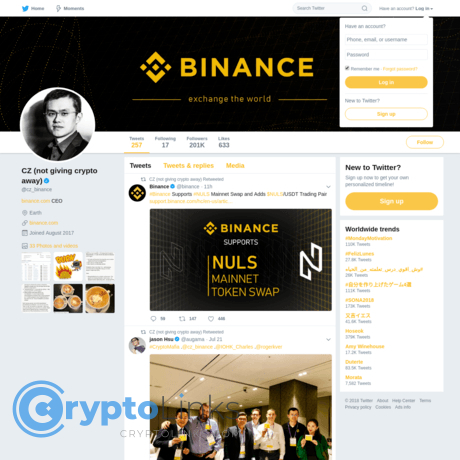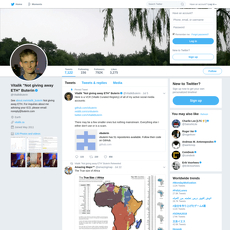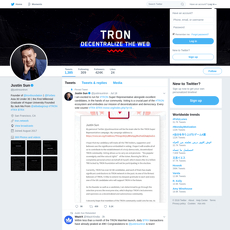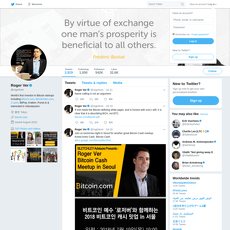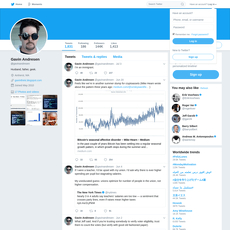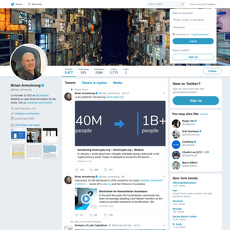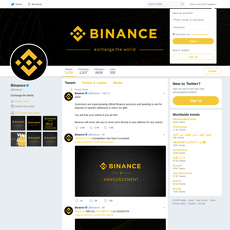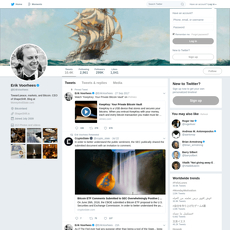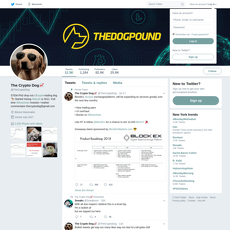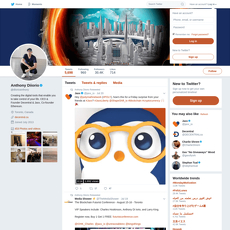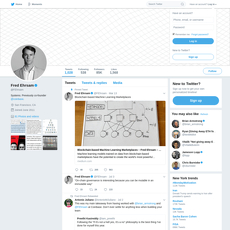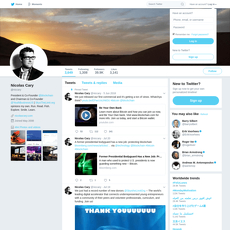Changpeng Zhao Review
Changpeng Zhao
twitter.com
Changpeng Zhao (@cz_binance) Review Guide: Everything You Need to Know + FAQ
Ever scroll CZ’s X feed and wonder what’s signal, what’s spin, and what’s a scam using his name?
You’re not alone. Between breaking headlines, legal updates, and Crypto Twitter’s constant hot takes, it’s hard to tell what’s official, what’s opinion, and what’s bait. Add the confusion around a so‑called “CZ coin,” questions about who actually owns what, and the way markets react to his posts — and it’s a lot.
Rule #1: Signals are rare. Noise is constant. Your edge is learning the difference.
Describe problems or pain
Here’s what trips most people up when they follow @cz_binance:
- Headline whiplash: Regulatory updates, court news, product launches, and rumors often land on the same day. Sorting fact from opinion takes time you don’t always have.
- Impostors and reply scams: Lookalike handles (think subtle character swaps), “giveaway” replies, fake support reps — they crowd every high‑engagement post. Research from MIT found that false news spreads faster than true news on Twitter/X, especially via novel, emotional hooks — exactly how impostors operate (MIT study).
- The “CZ coin” mix‑up: Tokens named after public figures pop up all the time. Name ≠ endorsement. Scammers count on that confusion.
- Verification is not enough: A blue check on X is paid, not proof of identity. You still need to verify handles, domains, and announcements.
- Portfolio FOMO: A single post can move sentiment in the short term. Acting on emotion, not process, is how people get trapped at the top.
This isn’t theoretical. Chainalysis’ 2024 report flagged that social‑engineering scams remain a core threat in crypto — impersonations, fake support, and giveaway schemes continue to siphon funds from users who click fast and verify slow (Chainalysis Crypto Crime reports).
Promise solution
Here’s how I’ll make this simple and useful for you:
- Context first: A quick timeline so you know what shaped CZ’s voice and why certain posts land the way they do.
- How to read his feed: What’s a real signal (product, policy, risk reminders) versus community talk or noise.
- Authenticity toolkit: Practical checks to confirm you’re looking at the real account and the real links.
- Scam radar: The exact red flags I see daily under high‑engagement posts.
- Clear answers: A no‑nonsense FAQ to resolve popular questions like “Is there a CZ coin?” and “Does he announce listings on X?”
End result: you’ll save time, avoid traps, and use @cz_binance as one helpful input — not your trading plan.
Who this guide is for
- Followers of @cz_binance who want clarity without the noise.
- Binance and BNB Chain users who need trustworthy signals and safer habits.
- Curious investors and builders who want clean answers without hype.
What you’ll get here
- A focused review of CZ’s public presence: what he tends to post and why it matters.
- An authenticity checklist: quick steps to confirm the handle, links, and claims.
- Myth‑busting around “CZ coin”: what’s real, what’s risky, and how to verify.
- Sharp, practical FAQ: fast answers to the most searched questions, with reliable references.
One more thing. I’ve spent years reviewing crypto platforms, tools, and influencers. The patterns are consistent: the best defense is a repeatable process you can run in under a minute. That’s what I’ll give you — and I’ll keep it tight, actionable, and bias‑free.
Ready to make sense of @cz_binance without getting pulled into the chaos? Great — next up, I’ll show you the 60‑second background that explains why his posts move the room, when they matter, and when you can safely scroll past. Want the quick snapshot so you can read his feed with confidence?
CZ at a glance: who he is and why he matters
Quick bio and early career
Changpeng Zhao, better known as CZ, is an engineer at heart. He studied computer science at McGill University and cut his teeth building trading systems—first at Bloomberg Tradebook, then by co-founding Fusion Systems in Shanghai, known for ultra-low-latency matching engines for high-frequency traders.
He discovered Bitcoin in 2013 and went all-in fast. He joined Blockchain.info (now Blockchain.com) as a developer and later served as CTO at OKCoin. In interviews, he’s said he sold his Shanghai apartment to buy BTC—a story Forbes and others have noted to underline his conviction.
“4: Ignore FUD, fake news and attacks. Keep building.”
— CZ, a mantra he repeated often during volatile years
That engineering + markets blend matters. It explains why his products focus on speed, scale, and incentives—and why he communicates like a builder, not a suit.
Founding Binance (2017) and rapid growth
In mid-2017, CZ launched Binance after a modest ICO for BNB (about $15M raised). The pitch was simple and relentless:
- Fast matching engine and global uptime during extreme volatility
- Low fees and BNB discounts that rewarded frequent traders
- Aggressive listings (especially in the 2017–2019 cycle) that attracted retail flow
- Referral mechanics that turned the community into a growth engine
The result: explosive network effects. By 2019–2020, Binance was the top spot exchange by volume, and by 2019 it had launched Binance Futures—quickly dominating derivatives, too. Multiple independent market data firms have tracked this dominance. For example:
- CCData has repeatedly placed Binance at or near the top for both spot and derivatives volumes through 2022–2024.
- Kaiko Research documented how Binance’s market share rose during zero-fee BTC promotions in 2022 and normalized after policy changes in 2023—illustrating how product tweaks ripple into market structure.
Meanwhile, the BNB ecosystem evolved from a fee-discount token into infrastructure:
- BNB Smart Chain (BSC) launched in 2020 as EVM-compatible, enabling cheap, fast DeFi and NFTs. PancakeSwap, Venus, and countless memecoins found a home there.
- The network later rebranded to the broader BNB Chain umbrella in 2022, reflecting multiple chains (execution + governance) and a push toward decentralization.
If you traded through the 2020–2021 DeFi summer, you felt it: fees on BSC were low enough to test ideas quickly. That reduced the “cost of curiosity,” which is why BNB Chain exploded with experimentation—even if not every experiment was pretty.
Key milestones and turning points
Here are the moments that shaped both Binance’s footprint and CZ’s public voice:
- 2018: “SAFU” fund — After a security incident, Binance created the Secure Asset Fund for Users (SAFU), an emergency insurance fund. The meme stuck, and “Funds are SAFU” became a reassurance line during market panics.
- 2019: Launchpad and the IEO boom — Binance kicked off the IEO trend, routing curated token sales through the exchange. It brought a “storefront” feel to token distribution and cemented Binance as a kingmaker for retail attention.
- 2019: Binance Futures — Perpetuals and leverage made Binance a must-use venue for active traders. By 2021–2022, derivatives volumes regularly outpaced spot, a pattern CCData has chronicled across the industry.
- 2020: CoinMarketCap acquisition — Binance acquired CoinMarketCap, the most visited crypto data site, fueling debates about neutrality and ecosystem reach.
- 2020: BNB Smart Chain goes live — EVM compatibility + low fees pulled massive developer and retail activity into the BNB orbit.
- 2021: Global regulatory pressure — Warnings from agencies in the UK, Japan, and elsewhere pushed Binance to tighten KYC, limit certain products, and reshuffle entities. This period hardened CZ’s “keep building” tone.
- 2022: Industry crisis and Proof of Reserves — After FTX’s collapse, Binance rolled out a SAFU balance page and a Proof of Reserves system. While PoR isn’t a full audit, it raised the bar for transparency across exchanges.
- 2022–2023: Zero-fee promotions and market share whiplash — Binance’s zero-fee BTC trading boosted spot share. When fees normalized in 2023, Kaiko and CCData both showed market share settling lower—evidence that incentives move liquidity fast.
- 2023: BUSD wind-down — Following a New York regulator’s order, Paxos stopped minting BUSD, and Binance pivoted liquidity to alternatives like FDUSD. Source: Reuters.
Each shift altered how CZ communicated. The early “hyper-growth” voice gave way to risk reminders, compliance talking points, and the now-famous “4” when the noise got loud. The message: keep building, verify, and ignore distractions.
Leadership change and legal chapter (2023–2024)
In November 2023, the U.S. Department of Justice announced a sweeping settlement with Binance. The company and CZ pled guilty to violations of U.S. anti-money-laundering and sanctions laws. Binance agreed to a multi-year compliance monitorship and to pay penalties totaling $4.3 billion. CZ stepped down as CEO the same day. Source: U.S. DOJ.
In April 2024, CZ was sentenced to four months in prison. He has stated publicly that he plans to focus on education and early-stage support for builders after serving his sentence—projects like online learning initiatives have already been mentioned. Source: Reuters.
Operationally, leadership moved to Richard Teng, while Binance continued functioning under new controls. Practically, that means CZ’s posts now carry a different weight: less as the sitting CEO, more as a prominent founder with a massive audience and a builder’s lens. When he speaks, the market still listens—but the context of his role has changed.
Here’s the emotional truth: love him or hate him, you’ve probably felt a CZ headline swing your watchlist. That’s what happens when someone sits at the intersection of liquidity, retail attention, and builder energy for years. The story isn’t tidy. It’s fast, messy, and very human.
So the real question now is simple: how do you read his feed—today—without falling for noise, fake accounts, or engineered hype? Keep going; I’ll show you exactly how to spot the signals, decode “4,” and avoid the traps in the next section.
How to read @cz_binance like a pro
I know the feeling: your feed explodes, everyone’s quoting a short line from CZ, and you’re wondering if you should act. Take a breath. If you learn how to read his posts in context, you’ll save time, avoid traps, and make clearer decisions—without getting pulled into every hot take.
“Funds are SAFU.”
That line is a comfort in stressful moments, but it’s not a trading signal. Here’s how I separate the useful signal from the noise when I follow @cz_binance.
What CZ typically posts
His feed blends product talk, risk reminders, and community notes. I bucket them like this:
- Product and ecosystem updates: References to Binance features, BNB Chain upgrades, education initiatives, or community programs. These are most useful when paired with official docs or a blog link. If there’s no link, I wait for one on Binance’s blog or BNB Chain.
- Risk and mindset reminders: Short posts warning about scams, over-leverage, or FOMO. Treat these as guardrails, not market calls.
- Community engagement: Shoutouts to builders, hackathons, or education projects (for example, personal education ideas he’s shared post-Binance). Good for discovery, but not endorsements of specific tokens.
- Culture memes and shorthand: At times he’s used simple signals like “4” to say “ignore FUD.” These shape sentiment, but they’re not trading cues.
When I see a post without a link, I treat it as context. When I see a post with an official link, I dig in.
Authenticity checklist (avoid impostors)
X/Twitter checkmarks aren’t enough anymore. I verify identity and claims in under a minute:
- Handle: Only trust @cz_binance. Watch for tiny swaps like “@cz—binance” or extra underscores.
- Profile sanity-check: Long post history, millions of followers, and interactions from official accounts are table stakes. New accounts with “Founder of Binance” in the bio are almost always fakes.
- Link hygiene: Big claims should point to binance.com or bnbchain.org. If a post mentions airdrops, listings, or wallets but links elsewhere, I assume scam until proven legit.
- Cross-reference: For anything market-moving or product-critical, I check:
- Binance Blog and Support
- BNB Chain site and BscScan for contract addresses
- Tool-assisted checks: If a link feels off, I run it through urlscan.io or VirusTotal and look for redirects, newly registered domains, or suspicious scripts.
“Trust but verify” sounds slow. It’s not. It’s a 60-second habit that beats months of regret.
Red flags and scams to avoid
Scammers love high-visibility feeds. They hijack replies under viral posts and impersonate authority. A few patterns I see repeatedly:
- Reply “giveaways” and live-stream airdrops: “Send 1 BNB, get 2 BNB.” This trope never dies. The FTC has tracked billions in losses from social-media-initiated scams since 2021, and investment cons are a leading driver.
- “SAFU/Proof-of-Reserves airdrop” clones: Posing as security programs to trick you into signing approvals. Chainalysis notes scammers shift lures with the news cycle—impersonation is their go-to move (2024 Crypto Crime insights).
- Phishing domains with lookalike characters: bìnance.com, binanće.com, or random TLDs like .help/.live/.pro. The Anti-Phishing Working Group keeps reporting record phishing activity—assume lookalikes are hostile (APWG trends).
- New tokens using his name or avatar: If a token piggybacks his identity, I treat it as a memecoin (best case) or a rug setup (worst case). No official link, no trust.
- “Support/Recovery Team” DMs: Nobody legit asks for seed phrases, screenshots of wallet keys, or “temporary access” for troubleshooting. Ever.
Two quick reality checks I use:
- Domain test: If it’s not on binance.com/bnbchain.org, I pass. No exceptions for “limited-time” events.
- Contract test: I paste the contract into BscScan, check holders, mint authority, and liquidity locks. If ownership isn’t renounced and a single wallet controls most supply, that’s a hard no for me.
Reading between the lines
Tone and timing are everything. Here’s how I read them:
- Market stress posts: Short, calm notes like “stay SAFU” or links to risk guidance usually mean “focus on security,” not “buy or sell now.”
- Regulatory context: When he references compliance or industry standards, I treat it as macro context. Helpful for understanding policy mood, not a green light on a trade.
- Product mentions without specifics: If there’s no ticker, date, or official doc, I assume it’s general interest—not a hidden listing hint.
- Silence is also a signal: If rumors fly and he doesn’t engage, I don’t “read into” it. No comment ≠ secret confirmation.
- Community applause: Retweets about builders or hackathons are invitations to learn, not endorsements. I look for funding details, eligibility, and official pages before acting.
Emotionally, it’s tempting to treat every line like a puzzle. Resist that urge. The best traders I know use his posts the same way they use earnings calls in equities: context first, execution second.
What not to expect
- No private DMs. If “CZ” messages you, it’s a fake. Report and move on.
- No surprise listings in replies. Listings appear on official channels, not in random threads.
- No secret investment clubs. “Early access groups” using his name are manufactured bait.
- No request for funds or wallet access. Real leaders don’t need your seed phrase.
If you’ve ever felt that spike of adrenaline after a cryptic post, you’re not alone. The trick is turning that energy into smart checks instead of rushed clicks.
Curious about the “CZ coin” rumors and how scammers wrap entire tokens around his name? I’m about to pull that apart—what’s real, what’s marketing theater, and what’s outright bait. Ready to see how the trick works before you see it again?
Myths, fakes, and the “CZ coin” confusion
Is there a real “Changpeng Zhao coin”?
I get this question all the time. Here’s the clean answer: tokens using CZ’s name exist on public networks, but that does not make them official, endorsed, or safe.
You’ll find multiple lookalike tokens on BNB Smart Chain with “CZ,” “Changpeng,” or “Zhao” in the name. A quick scan on explorers often shows fresh contracts, thin liquidity, and anonymous deployers. For example, some news aggregators in 2024 surfaced a BEP‑20 token branded “Changpeng Zhao (czonbnb.com).” That kind of branding hooks attention—but brand names are not verification.
- Reality check: Name-based tokens are typically memecoins. Unless CZ or Binance clearly says, “This is ours,” assume it’s unofficial.
- Where to verify: Check Binance Announcements and CZ’s handle @cz_binance. No mirror there? Don’t touch it.
- What I look for: a signed, consistent message across official domains, not screenshots, Telegram whispers, or “leaks.”
Rule #1: If a claim uses CZ’s name but can’t be verified on Binance’s official channels, treat it as a scam until proven otherwise.
How scammers use CZ’s name
Impersonation is the oldest trick in crypto. It still works because it’s fast, emotional, and it rides moments of hype.
- Reply bots under viral posts: “Surprise CZ giveaway—double your BNB!” They use lookalike domains like binànce.com (notice the accented character) to drain wallets.
- Fake support reps: They DM you after you complain in a thread. They’ll ask for a “verification deposit” or seed phrase. Real support won’t do that.
- “Investment programs” with guaranteed returns: They claim CZ backing, promise 3–5% daily, and show forged dashboards. This is straight-up Ponzi pitch.
- Airdrop phishing: “Exclusive CZ airdrop—connect wallet.” You’ll be asked to sign approvals like Permit or setApprovalForAll. That’s how drainer contracts get unlimited spending rights.
- “Listing pre-sale” or “token swap” notices: They play on big news cycles. If Binance didn’t post it, it’s fiction.
If you’re thinking “who falls for this?”, the answer is: busy people. The FTC has repeatedly warned that crypto is a favorite rail for scammers, and industry reports (like Chainalysis’ annual crime studies) show impersonation and phishing remain stubbornly effective. The hooks change, the pattern doesn’t.
Safe steps before you click or buy
Here’s my simple, no-excuses workflow when something flashes “CZ” in the title:
- Match the source: Only trust announcements mirrored on both @cz_binance and Binance’s site. One without the other is a red flag.
- Check the domain by hand: Type it yourself. No clicking. Watch for subtle character swaps and extra hyphens. When in doubt, stop.
- Verify the smart contract:
- Pull it from the official post, not from a random reply.
- Open BscScan: look at contract age, verified source code, holder concentration, mint/pause privileges, and whether ownership is renounced or controlled by an upgradeable proxy.
- Check liquidity: is it locked? How much? Use tools like GeckoTerminal or DexTools.
- Scan for honeypot behavior with reputable scanners (and still assume risk).
- Watch the wallet prompts: If a site asks for unlimited approvals or strange signatures you don’t understand, cancel. Then review allowances on Revoke.cash.
- Block and report impostors: On X, use the “Report” function for fake CZ/Support accounts. Don’t argue—just remove them from your feed.
- Keep your guard up in DMs: No real team will ask for a seed phrase, remote access, or a “test transaction.” Ever.
If you still want to speculate on name-based tokens, treat it as a meme trade: small size, clear stop, no emotions. Fun money only.
Bottom line
“Named after” ≠ “official.” A token can say “Changpeng Zhao” in big bold letters and still be a stranger’s weekend project. Until there’s a clear, verifiable statement on official channels, assume zero endorsement.
One last thought before we move on: if a random token using CZ’s name can whip up this much noise, what happens when he actually speaks about markets, builders, or policy? Does it still move the needle, or has that influence changed? Let’s answer that next.
CZ’s real impact: markets, builders, and policy
Market influence (tempered but still real)
When he posts, people still pay attention. Not because he shills coins—he doesn’t—but because his tone can shift sentiment. The clearest example was November 2022, when his comments about FTT and counterparty risk helped trigger a broader reassessment of exchange risk across the market. That moment wasn’t about a price call; it was about trust, and trust moves capital.
Since stepping away from day-to-day leadership, the market impact of his posts has cooled, but it hasn’t vanished. It’s more nuanced now—his updates can nudge liquidity, perk up builder attention on BNB Chain, or push risk discussions higher up your feed. Treat it as context, not a trading signal.
- What actually moves: messaging on compliance, security, and ecosystem support. Sentiment flows first, prices follow if volume confirms.
- What usually doesn’t: surprise listing hints or “alpha.” He doesn’t announce those by tweet replies.
- How I trade around it: I wait for confirmation—spot volume, perp funding rates, and on-chain activity—before I touch anything. No FOMO entries.
If you like receipts, research consistently finds social media attention can spark short-lived crypto moves—useful for timing, not a thesis. Good starting points: Reuters on the 2022 FTX cascade and academic work on Twitter-driven crypto returns (for example on SSRN).
“Ignore FUD. Keep building.” — a line that aged well, but it’s not a trade setup.
Builders and ecosystems
Behind the headlines, the most durable impact is on builders. BNB Chain still runs one of the most active EVM ecosystems, with real programs that outlast hype cycles.
- MVB (Most Valuable Builder): a long-running accelerator for early-stage teams on BNB Chain. Look for seasons, mentors, and post-cohort follow-through. Start here: BNB Chain MVB.
- Hackathons and bounties: regular tracks for DeFi, gaming, infra, and security. The signal: cash + credits + post-hack support (grants or incubations), not just swag.
- opBNB: BNB Chain’s rollup that targets cheaper transactions for games and consumer apps. Watch docs, daily tx, and unique wallets to gauge real adoption.
On-chain activity comes in waves, but BNB Chain has proven it can handle scale (it set a record of millions of transactions in a single day at peak activity). For founders, the opportunity is simple: apply where there’s budget, documentation, and distribution. If it only lives in a tweet, it’s probably noise. If it shows up in grants, repos, and a clear growth plan, it’s worth your time.
Regulation and global stance
His legal chapter reshaped the industry conversation. The 2023 settlement and his 2024 sentencing didn’t just change one company’s direction—they pushed the whole exchange category to get more serious about compliance, transparency, and risk management.
- Compliance became table stakes: more platforms moved to full KYC, clearer country restrictions, and better risk disclosures. Users are asking smarter questions about custody and jurisdictions.
- Proof-of-Reserves normalized: Binance’s Merkle-tree PoR (launched post-FTX) helped make reserve-attestations a user expectation. Many competitors followed with their own versions.
- Licensing > geo-gambling: the direction of travel is toward licensed, ring-fenced entities. Example: Binance FZE progressed in Dubai’s VARA framework in 2024; this is the pattern you should expect in other hubs too.
The net impact: fewer easy loopholes, more paperwork, and—if done right—a safer playing field for serious builders and capital. That’s not fun on Twitter, but it’s good for durability.
Personal projects after Binance
He’s been vocal about focusing on education and philanthropy, not spinning up another exchange. The standout is Giggle Academy, an education initiative aiming to deliver free, gamified learning for kids worldwide. It’s ambitious and non-crypto at its core.
- How I evaluate it (and anything similar):
- Check the official site and team page—who is building, what’s shipped, what’s open source.
- Look for timelines, pilot programs, and measurable outcomes (users, curriculum completed, engagement), not just vision posts.
- If there’s a token pitch tied to “education,” hard pass until there’s real need and transparent governance.
This chapter looks less like market-moving announcements and more like long-game impact. That’s fine. Real change isn’t always a chart spike; sometimes it’s a classroom that didn’t exist before.
Curious about the most asked questions next—like who actually owns Binance or whether there’s a real “CZ coin” you should care about? I’ll answer those directly in the FAQ with quick checks and clean sources—no fluff, no bait. Ready?
FAQ: quick, clear answers to the most asked questions
Who is the owner of CZ Binance?
Binance was founded in 2017 by Changpeng Zhao (CZ). The exchange is operated by private entities (commonly referenced as Binance Holdings Ltd.), and detailed cap-table ownership isn’t publicly disclosed. CZ was the founder and long-time leader. In November 2023, he stepped down as CEO following a U.S. settlement related to compliance failures, and in 2024 he was sentenced in connection with those issues. For the most accurate picture of current roles and leadership, always check official Binance announcements and the corporate page.
What is the Changpeng Zhao coin?
You’ll see tokens on BNB Smart Chain using his name (for example, reports in 2024 mentioned a BEP-20 token called “Changpeng Zhao (czonbnb.com)”). That doesn’t mean the token is official or endorsed by CZ or Binance. Treat any name-based token as a high-risk memecoin unless there’s a clear, verifiable statement from CZ or Binance.
- Quick check: Is the token announced on Binance’s official blog or CZ’s verified handle linking to an official Binance domain? If not, assume it’s unofficial.
- Contract verification: Look up the smart contract on BscScan and confirm the creator, ownership, and any suspicious functions (e.g., trading pause, minting to arbitrary addresses).
- Distribution red flags: If top wallets hold the majority of supply or liquidity is thin/unlocked, you’re looking at serious rug risk.
Bottom line: Name ≠ endorsement. If you’re buying only because it says “CZ,” you’re gambling, not investing.
Is CZ still CEO of Binance?
No. As of late 2023, CZ stepped down as CEO and leadership moved to a new chief executive. To confirm who’s currently in the role and any board or advisory changes, check Binance’s official site and press releases—they keep that page up to date.
What’s CZ’s official Twitter/X handle?
The official handle is @cz_binance. Scammers love lookalikes, so use this quick authenticity check:
- Exact handle match: @cz_binance (watch for character swaps like “@cz_blnance” with a lowercase “L”).
- History: A long post history, with older tweets archived and consistent messaging, is hard for fakes to replicate.
- Link trails: Posts should point to official domains (binance.com, bnbchain.org). Random airdrop or claim domains are a hard pass.
- No DMs for deals: CZ doesn’t DM you investment offers, account fixes, or “priority listings.” Anyone doing that is a scammer.
Does CZ announce listings or giveaways on Twitter?
Official listings are announced via Binance’s verified channels (website, app notifications, and @binance accounts). Treat Twitter/X “giveaways” with extreme skepticism unless they’re mirrored on Binance’s official pages.
- Scam pattern #1: “Retweet + tag 3 friends + connect wallet to claim” — designed to drain wallets or harvest keys.
- Scam pattern #2: “Surprise listing leak” in replies under a CZ tweet — fake screenshots, counterfeit domains, and Telegram bait.
- Scam pattern #3: “Binance support” accounts replying to users — Binance support doesn’t ask for seed phrases or remote access. Ever.
If a “giveaway” isn’t on binance.com or Binance’s verified social pages, it’s not real.
Should traders act on CZ’s tweets?
Use them as context, not a trading signal. Sentiment can flip fast and liquidity hunts love overreactions. Here’s how I keep it practical:
- Confirm with primaries: If the tweet references a product or listing, check Binance’s blog or official announcements before you touch the buy button.
- Time your entries: Sudden spikes often retrace. Waiting for the next time frame (e.g., 15–60 minutes) and letting price stabilize can reduce FOMO mistakes.
- Position sizing: Keep positions small around newsy moments. If the info is legit, there’s usually a second, cleaner entry after the first reaction.
- Risk first: Set stop-losses and define invalidation. Tweets don’t protect you from whipsaws.
I’ve tracked plenty of “Twitter-pump” reactions since 2021. Most quick spikes faded within 24–72 hours unless backed by a real, confirmed catalyst with clear timelines. Treat tweets as a starting point for research, never the finish line.
Want a simple 10-second checklist to spot fakes and stay safe? Keep going—I’ll share the exact steps I use every day next.
Next steps and a simple plan to stay safe
Your quick checklist
I keep this short list pinned in my notes. It’s the fastest way to stay sharp when scrolling X and skimming headlines.
- Follow the real handle only: @cz_binance. Make an X “List” just for verified crypto accounts so replies don’t flood your main feed.
- Bookmark the official pages: binance.com, Binance Announcements, bnbchain.org. If a claim isn’t mirrored there, treat it as noise.
- Never click links in replies. Impostors farm replies under popular posts. Open the profile bio or the official site directly instead.
- Check the domain, then the path. “binance.com” is good; “binance-com[.]xyz” or “binance[.]support” is not. On mobile, long-press to preview the full URL.
- Wallet safety rule: Don’t sign approvals on random sites. If a page asks for Permit or SetApprovalForAll, stop and simulate first (Rabby, MetaMask Simulation), then review/undo allowances at revoke.cash.
- Harden your accounts: Use a hardware wallet for long-term funds. On exchanges, enable TOTP or a security key and turn off SMS 2FA.
- Ignore all DMs “from CZ.” He’s not DM-ing you. Report and move on.
- Treat name-based tokens as unverified. If you see a “CZ” coin, verify the BscScan contract, creator, mint functions, and whether ownership is renounced. No clear, official announcement = pass.
- Listings sanity check: Real listings appear on the Announcements page and main channels. If you don’t see it there, it’s not happening.
- Run a cooldown. Wait 30–90 minutes before acting on any social post. Quick reactions fuel mistakes; patience protects capital. Research on investor behavior shows overtrading and reactionary moves hurt returns over time.
Simple rule: If it’s not on binance.com/en/support/announcement, I don’t click, connect, or commit.
If you want deeper context
Here’s the workflow I use when something big hits my feed.
- Classify the post. Is it a product update, an opinion, a security reminder, or community banter? Your next step depends on the type.
- Pull the primary source. For products/policy, read the linked docs or announcement on official domains. No link? Search the official site yourself.
- Cross-check claims. Compare with reputable trackers or press. If it’s a “listing,” verify on the official Announcements page, not screenshots.
- For tokens, check the chain data:
- Contract on BscScan
- Creator wallet and deploy history
- Mint/blacklist functions and proxy upgrades
- Top holders and liquidity locks
- Score the risk. A: official announcement and docs; B: semi-confirmed, needs time; C: rumors or replies only. Only act on A. Consider B after time passes. Ignore C.
- Size properly. Cap any trade sparked by social chatter to a small slice (for me, 0.5–1% of the portfolio max) and set a pre-defined exit.
- Log the decision. Keep a 1-minute note with the link, your thesis, and the risk. It kills FOMO and improves your process.
Why the caution? Impersonation and phishing remain steady threats. Security teams have tracked wallet-draining schemes using fake “airdrop” and “support” links stealing hundreds of millions of dollars in recent years. Phishing trends across the web continue to grow, and crypto is a prime target. Good habits beat any single tool.
Real-world sample (how I handle a sketchy “announcement”)
You see a reply under a popular post: “BREAKING: New Launchpool — stake BNB to farm $NEW. Claim here: binance-labs.app/launch”
- Step 1: Check the domain. Not binance.com — instant red flag.
- Step 2: Open the official Announcements and search “Launchpool $NEW.” Nothing there? Close the tab.
- Step 3: If you already interacted, immediately revoke approvals via revoke.cash and rotate wallet keys if needed.
Final notes for creators and investors
- Builders: Focus on real programs with published criteria and public winners. Look for grants and hackathons listed on official BNB Chain pages and recognized platforms (e.g., hackathon portals with on-chain prize payouts). If a “grant” contacts you by DM and asks for wallet connections or upfront fees, it’s a scam.
- Ship with transparency: Public repos, audits, and testnets earn trust. Avoid using a public figure’s name or logo in your token/branding unless you have explicit, documented permission.
- Investors: Never buy a token because a name sounds familiar. Require an official announcement, a verified contract, clear tokenomics, and credible liquidity. Set max position sizes and let time, not tweets, confirm your thesis.
- Guardrails that help: pre-set stop losses, calendar-based reviews, and a “no trade during hype spikes” rule. Fewer, better bets beat chasing every headline.
Closing thoughts
CZ’s feed can be useful, but only when you run it through strong filters. Keep your checklist handy, verify claims on official pages, and default to patience. The edge isn’t in being the fastest clicker—it’s in making clean decisions with sturdy risk management.
CryptoLinks.com does not endorse, promote, or associate with Twitter accounts that offer or imply unrealistic returns through potentially unethical practices. Our mission remains to guide the community toward safe, informed, and ethical participation in the cryptocurrency space. We urge our readers and the wider crypto community to remain vigilant, to conduct thorough research, and to always consider the broader implications of their investment choices.

